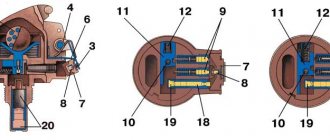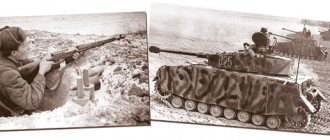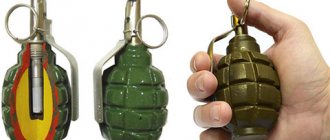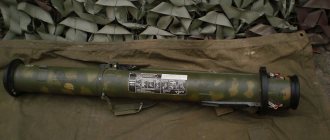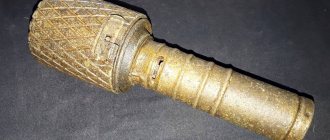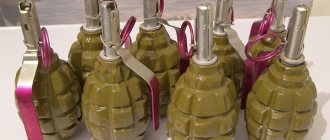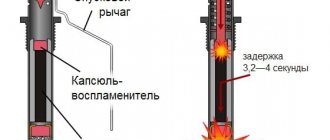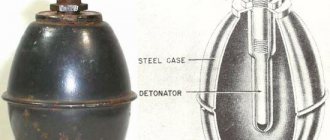This term has other meanings, see M26.
| M26 defensive hand grenade | |
| Type: | hand defensive grenade |
| A country: | USA |
| Service history | |
| In service: | US Armed Forces |
| Production history | |
| Designed by: | 1960s |
| Characteristics | |
| Weight, kg: | 0.450 |
| Length, mm: | 93 mm (without fuse) |
| Diameter, mm: | 57 |
| Explosive: | composition B |
| Mass of explosive, kg: | 0.165 |
M26 (grenade)M26 (grenade)
M26
- American defensive hand grenade. Developed before the Korean War of 1950–1953.
Design
The M26 has an egg-shaped metal body made up of two halves. A spiral of cut steel wire is tightly laid along the inner surface of the body. Explosive charge - 165 grams of composition B. During the explosion, about 1200 small fragments are formed, giving a zone of continuous destruction within a radius of 9 m and maintaining a lethal effect at a distance of 15-20 m. Although the grenade is considered defensive, the rapid loss of lethal energy by fragments allows the grenade to be used both in defense as well as attack. The grenade can be used with M204A1 and A2, M205A1 and A2, M125 remote fuses.
Story
The M26 was developed as a result of research into the Mk 2. Unlike its previous counterpart, its M204A1 fuse[3] produces no obvious smoke or sparks when ignited, and its powder feed is nearly silent while it burns.[4] This Composition B filler was considered safer than the flake or granular TNT filler used in the Mk 2.
The M26 series was created after World War II to meet criticism of the Mk 2. The original M26 replaced the Mk 2 Fragmentation Grenade as the Army's standard issue in Korea. Mass production during World War II left the Mk 2 as a limited standard issue for the US Army and US Marines through the 1960s and the US Navy until the 1970s. The M26A1/M61 was the primary fragmentation grenade used by American forces in the Vietnam War.
The M26 series (M26/M61/M57) was replaced by the M33 series grenade launcher (M33/M67) at the end of the Vietnam War.
Excerpt characterizing the M26 (grenade)
“A lot, if he has 40 thousand troops,” Weyrother answered with the smile of a doctor to whom a doctor wants to indicate a cure. “In this case, he is going to his death, waiting for our attack,” Langeron said with a thin ironic smile, looking back at the nearest Miloradovich for confirmation. But Miloradovich, obviously, at that moment was thinking least of all about what the generals were arguing about. “Ma foi, [By God,” he said, “tomorrow we will see everything on the battlefield.” Weyrother grinned again with that smile that said that it was funny and strange for him to meet objections from the Russian generals and to prove what not only he himself was too sure of, but what the emperors were sure of. “The enemy has put out the fires, and a continuous noise is heard in his camp,” he said. - What does it mean? “Either he moves away, which is the only thing we should be afraid of, or he changes his position (he grinned). But even if he took a position in Tyuras, he only saves us from a lot of trouble, and all the orders, down to the smallest detail, remain the same. “How then?” said Prince Andrei, who had been waiting for a long time for an opportunity to express his doubts. Kutuzov woke up, cleared his throat heavily and looked around at the generals. “Gentlemen, the disposition for tomorrow, even today (because it’s already the first hour), cannot be changed,” he said. “You heard her, and we will all do our duty.” And before a battle, there is nothing more important... (he paused) than getting a good night's sleep. He pretended to stand up. The generals took their leave and left. It was already past midnight. Prince Andrei left. The military council, at which Prince Andrei was not able to express his opinion, as he had hoped, left a vague and alarming impression on him. He did not know who was right: Dolgorukov and Weyrother or Kutuzov and Langeron and others who did not approve of the attack plan. “But was it really impossible for Kutuzov to directly express his thoughts to the sovereign? Can't this really be done differently? Is it really necessary to risk tens of thousands and my, my life for the sake of court and personal considerations?” he thought. “Yes, it’s very possible they’ll kill you tomorrow,” he thought. And suddenly, at this thought of death, a whole series of memories, the most distant and most intimate, arose in his imagination; he remembered the last farewell to his father and wife; he remembered the first times of his love for her! He remembered her pregnancy, and he felt sorry for both her and himself, and in a nervously softened and excited state he left the hut in which he had stood with Nesvitsky and began to walk in front of the house. The night was foggy, and moonlight mysteriously broke through the fog. “Yes, tomorrow, tomorrow! - he thought. “Tomorrow, perhaps, everything will be over for me, all these memories will no longer exist, all these memories will no longer have any meaning for me.” Tomorrow, maybe, even probably, tomorrow, I foresee it, for the first time I will finally have to show everything that I can do.” And he imagined the battle, its loss, the concentration of the battle on one point and the confusion of all the commanders. And now that happy moment, that Toulon, which he had been waiting for so long, finally appears to him. He firmly and clearly speaks his opinion to Kutuzov, Weyrother, and the emperors. Everyone is amazed at the correctness of his idea, but no one undertakes to carry it out, and so he takes a regiment, a division, pronounces a condition so that no one will interfere with his orders, and leads his division to the decisive point and alone wins. What about death and suffering? says another voice. But Prince Andrei does not answer this voice and continues his successes. The disposition of the next battle is made by him alone. He holds the rank of army duty officer under Kutuzov, but he does everything alone. The next battle was won by him alone. Kutuzov is replaced, he is appointed... Well, and then? another voice speaks again, and then, if you are not wounded, killed or deceived ten times before; Well, then what? “Well, then,” Prince Andrei answers himself, “I don’t know what will happen next, I don’t want and can’t know: but if I want this, I want fame, I want to be known to people, I want to be loved by them, then It’s not my fault that I want this, that this alone is what I want, this alone is what I live for. Yes, for this alone! I'll never tell anyone this, but oh my God! What should I do if I love nothing but glory, human love? Death, wounds, loss of family, nothing scares me. And no matter how dear and dear many people are to me - my father, sister, wife - the most dear people to me - but, no matter how scary and unnatural it seems, I will give them all now for a moment of glory, triumph over people, for love for to myself people whom I do not know and will not know, for the love of these people,” he thought, listening to the conversation in Kutuzov’s yard. In Kutuzov's yard the voices of the orderlies were heard; one voice, probably the coachman, teasing the old Kutuzovsky cook, whom Prince Andrei knew, and whose name was Titus, said: “Titus, what about Titus?”
Options
M26A1
The M26A1 is an M26 with the fragmentation coil redesigned to have a square rather than round cross-section, as well as deeper serrations for easier fragmentation. He also added a small tetryl charge to his fuze to fully detonate the explosive charge (shifted to 5.5 ounces due to the added booster charge) and used an updated M204A2 fuze.[3] It was adopted by the United States in 1958.
M26A2
The M26A2 is an M26A1 modified to take advantage of the M217 impact. fuse.[3] It is slightly thicker than the M26A1 and has the word "IMPACT" stamped on the safety. On earlier models, the lever was painted red with "IMPACT" written in black paint.[5].
M30
The M30 is a training version of the M26 grenade. It had a cast iron two-section oval body with a plastic plug. The designation RFX55 was stamped on the case; Initially, an experimental hand grenade was created on it, which was never put into production. It was filled with 21 grains of black powder and used M10A3/M10A4 or M204A1/M204A2 series fuses. Its body is colored blue with a brown stripe down the middle. When the grenade exploded, the excess pressure caused the plug to pop out and release a stream of black smoke caused by the burnt filler.
M61
M61 with additional safety clip
The M61 is an M26A1 with an additional safety (called a "jungle clip") attached to the safety lever. This is to prevent the safety lever from flying off and allowing the striker to fire if the safety pin accidentally gets pulled out and gets caught in the jungle.[4]
The most common way to carry grenades is on pouch straps. Soldiers, inspired by characters from films and television shows, also commonly hung grenades on themselves using safety levers, although it is said that "official policy prohibits this practice as unsafe." [ citation needed]
]
M62
The M62 is a practical version of the M26A1/M61, but with a larger 5/8-inch fuze compartment. It is filled with 37.5 grains of black powder and uses an M228 fuze. Its body and lever are painted blue to identify it as a practice grenade, and it has a "jungle clip" like the M61.
M50
The M50 was a "live fire" conversion of the M30 practice grenade for use on firing ranges. It sealed the base plug, used the M204A1 fuze, and replaced the low-explosive black powder filler with high-explosive Compound B. This allowed recruits to be trained more safely because it lacked the M26's fragmentation coil and had less blast. radius. It also made use of obsolete ammunition by using worn-out M30 casings as a base.
M56
The M56 is an M26A1 with a larger 5/8-inch fuze. It uses the M215 detonating fuze (4-5 second delay) and has a "jungle clip" like the M61. The M215 is similar to the M213 safety used in the M33 series grenades except that it has a curved lever rather than the curved straight lever of the M213.
M57
The M57 is an M26A2 with the safety attached to the lever.
L2 (UK)
British fragmentation grenade L2-A2
B Series L2
(with green body) - British version of the M26;
has a 4.4 second fuse. The L2 was similar to the early M26 (except that it used the L25 series fuze), the L2A1 was similar to the improved M26A1, and the L2A2 was a variant of the L2A1 with a modified fuze block to facilitate mass production.[6] The L3 series
(with a blue shell and black powder filling) is a variant of the training grenade.[6][7]
The L4 series
(with a dark blue shell, non-functional fuze and no filler) is an inert version of the Drill grenade.[6][7]
References
- ^ a b c d
LEKSPEV. "M26, M26A1 and M61". Lexpev.nl. Retrieved 2014-05-03. - "Hand grenades." Inetres.com. Retrieved 2014-05-03.
- ^ a b c d
"Archival copy". Archived from the original on 2016-03-04. Retrieved 2013-03-19.CS1 maint: archived copy as title (link to site) Training manual Grenades TM-9-1330-200-12. Table 1: Authorized hand grenades3 - ^ a b c
Copyright 2001-2005 Inert-Ord.net. "US M61 Fragmentation Grenade (Vietnam)." Inert-Ord.net. Retrieved 2014-05-03. - TM 43-0001-29 Grenades
(chg 4, 2002). - ^ a b c Military Factory L2 Anti-personnel fragmentation hand grenade
- ^ a b c
"M26". Archived from the original on 2015-11-17. Retrieved 2013-02-24. - LEKSPEV. "Australian garnets" Lexpev.nl. Retrieved 2014-05-03.
- LEKSPEV. "Canadian grenades" Lexpev.nl. Retrieved 2014-05-03.
- https://www.indumil.gov.co/product/granada-imc-mg-m26-he/
- LEKSPEV. "L2 series". Lexpev.nl. Retrieved 2014-05-03.
- LEKSPEV. "M-26". Lexpev.nl. Retrieved 2014-05-03.
- https://www.israelnationalnews.com/News/News.aspx/154626#.UaPin5zi6F1 Lessons from tragedy, IDF develops safer hand grenade
(04/09/2012), Israeli National News - https://bemil.chosun.com/nbrd/gallery/view.html?b_bbs_id=10044&pn=1&num=177361
- LEKSPEV. "Portuguese garnets" Lexpev.nl. Retrieved 2014-05-03.
- LEKSPEV. "South African Pomegranates" Lexpev.nl. Retrieved 2014-05-03.
- Denel Land Systems. "Grenade Passports" (PDF). Archived from the original (PDF) on September 14, 2006. Retrieved November 3, 2022.
- McNab, Chris (2002). Military uniform of the 20th century
(2nd ed.). Kent: Grange Books. p. 308. ISBN 1-84013-476-3.
Links[edit]
- Allen, Edward A. Technical Progress Report: Failures of the C12 Detonator in the Illuminated Hand Grenade EX 1 Mod 0.
China Lake, California: Naval Test Station, 1963. - Dockery, Kevin. Special weapons for special purposes
. Chicago: Emperor's Press, 1997. ISBN 1-883476-00-3. - Gervasi, Vol. Arsenal of Democracy III: America's War Machine.
New York: Grove Press, 1984. ISBN 0-394-54102-2 - Hogg, Ian W. The American Arsenal
. Mechanicsburg, PA: Stackpole Books, 2001. 1-85367-470-2. - US government. US Army, Army Concept Group in Vietnam. Final report on the chemiluminescent hand grenade.
Army concept group in Vietnam, 1966.
Users
- Australia: Australia adopted the M26, but it was replaced by the F1 Grenade.[8]
- Brazil: Used by the Brazilian Army.[7]
- United States: The M26 was introduced during the Korean War. It was a limited standard issue early in the Vietnam War and was soon replaced by the M26A1/M61 (1958), M26A2/M57 (1960) and M33/M67 (1968) as standard issue.
- Canada: Canada adopted the M61, but has since been replaced by the C13 grenade, a Canadian variant of the M67 grenade launcher.[9]
- Colombia: Used by the Colombian Army. Produced by the Colombian Military Industry.[10]
- United Kingdom: The L2 series replaced the M36 Mills Bomb in British service. It was almost completely replaced by the L109 grenade.[11]
- Israel: The M26A2 was adopted in Israel as the M26 and is still used in that country.[12] The 2012 version added an improved fuse to ensure the grenade would not explode when hit by an enemy bullet.[13]
- North Korea: Used by North Korean special forces.[14]
- Philippines: Used by the Armed Forces of the Philippines and Philippine National Police-Special Action Group
- Portugal: Portugal adopted the M26A1 and produced it under license as the M312
.[15] - South Africa: South Africa produced the M963
, itself a variant of the Portuguese
M312
, under license.[16]
Later production would include a copy of the standard M26 grenade, designated the M26 HE Hand Grenade,
and a blue training version with a reusable aluminum casing, designated the
M26 Training Hand Grenade
.[17] - South Vietnam:[18] South Vietnam received an M26 grenade as US aid. Production and sales of the M26 continued in South Vietnam even after the US military adopted the M26A1/M61 and M33/M67.
CONTENT
- 1 High explosive, fragmentation and explosive 1.1 Mk II and Mk IIA1
- 1.2 Mk III, Mk IIIA1 and Mk IIIA2
- 1.3 M26/A1/A2, M57 and M61
- 1.4 M33, M33A1/M59, M67 and M68
- 1.5 Scalable Offensive Hand Grenade
- 1.6 ET-MP
- 2.1 M1 Fragmentation Grenade (FS)
- 3.1 M1 Frag Grenade (AC, CNS and M1)
- 4.1 M1 Fragile Grenade (AW, Alcohol Gasoline, GA, IM and NP)
- 5.1 M116/A1 and "Flash-Crash"
Variants
M26A1
M26A1 e M26, which is reeled for fragmentation, has been reworked in such a way that it is square, and not completely round, the cross-section and the name are long-winded, for the sake of fragmentation. Then add a small tetryl booster charge to your bushon until the explosive detonator is completely detonated (up to 5.5 ounces for adding a booster) and use the actualization of the M204A2.[3] Welcome to the American Service Prez 1958
M26A2
M26A2 e M26A1, modified, receiving the M217 bouchon strike.[3] It's a little different from the M26A1 and is designed with relief with the inscription "IMPACT" on the top of it. Early models of imah boyadisan in black and white with the inscription “IMPACT”, drawn from black [5].
M30
The M30 is practically a version of the M26 grenade. The toy imash has a cast iron oval body made of two parts with plastic tape. Tyaloto boldly symbolize “RFX55”; It was originally founded as an experimental hand grenade, but was never put into production. That imash polnitel from 21 grains is black dust and crawled out of your series of M10A3 / M10A4 or M204A1 / M204A2 viewers. Tyaloto mu e boydisano in light blue with kafjava tape prez sredata. Kogato grenade detonir, svrkhnalyaganeto nakara zushalkata and jumped out and empty stream of black dim, caused by burning of the fuel.
M61
M61 showing an additional security bracket
M61 e M26A1 with additional security (called the “jungle pinch”), attached to the security hole. Tova e, for yes, prevent the loss from the enemy and allow it to attack the attacker and the functionary, as soon as the shield is accidentally destroyed, when the vegetation is captured by the jungle.[4]
The best way to meet the method is to carry out the grenade and through the recovery of the ammunition. Voinitsite, inspired by the heroes of VV films and television legends, sscho ochasto okachvat grenati na svoite khora, izpolzvayki predazanite Lostovo, contrary to che se kazva, che “the official policy of the abusive practice is cato dangerous.” [ necessary e citations
]
M62
The M62 is almost a version of the M26A1 / M61, but with 5/8-inch frames. Toy ima pilnitel from 37.5 grains of black dust and crawling of the representative M228. Tyaloto and lostt mu sa boydisani in sinyo, for da go identifitsirat kato practical grenade and ima “pinch for the jungle” kato M61.
M50
The M50 is quickly converted to the M30 Practice grenade for “live fire” for use at the training grounds. That sealing of the main chips, from the crawl of the M204A1 representative and the replacement of a low explosive hazard, a black dusty incinerator with a highly explosive composition of V. Tova, allowing training for new recruits with a po-golyam of security, the kato lipsva naksanata winding on the M26 and ima little by little exploding radius. Tova is crawling and aging orzhia, kato is crawling from wear and tear of the body M30 kato is its own basis.
M56
M56 e M26A1 with 5/8-inch barrels. That is the creep of the detonating predzatel M215 (stagnation from 4-5 seconds) and the ima “pinching the jungle” cato M61. M215 is similar to the predecessor M213, used in Granati from the M33 series with the exception of the product, which is crimped, and not similar to the rights of the M213.
M57
M57 e M26A2 with a "jungle" prep, attached to the main part.
L2 (United theft)
British fragmentation grenade L2-A2
The Series L2
(with green wrap) e British version on M26;
toy ima 4.4 seconds predpazitel. L2 is the best version of the early M26 (with the exception of the product, which is from your preferred product from the L25 series), L2A1 is the best version of the product M26A1, and L2A2 is the best version of the L2A1 with a reworked treasure for forestation on mass production.[6] The Series L3
(with light blue lining and black dust cover) is also an option for the Practice grenade.[6][7]
The Series L4
(with dark blue lining, non-functional eyepiece and without a trigger) is an inert option for the Drill grenade.[6][7]

